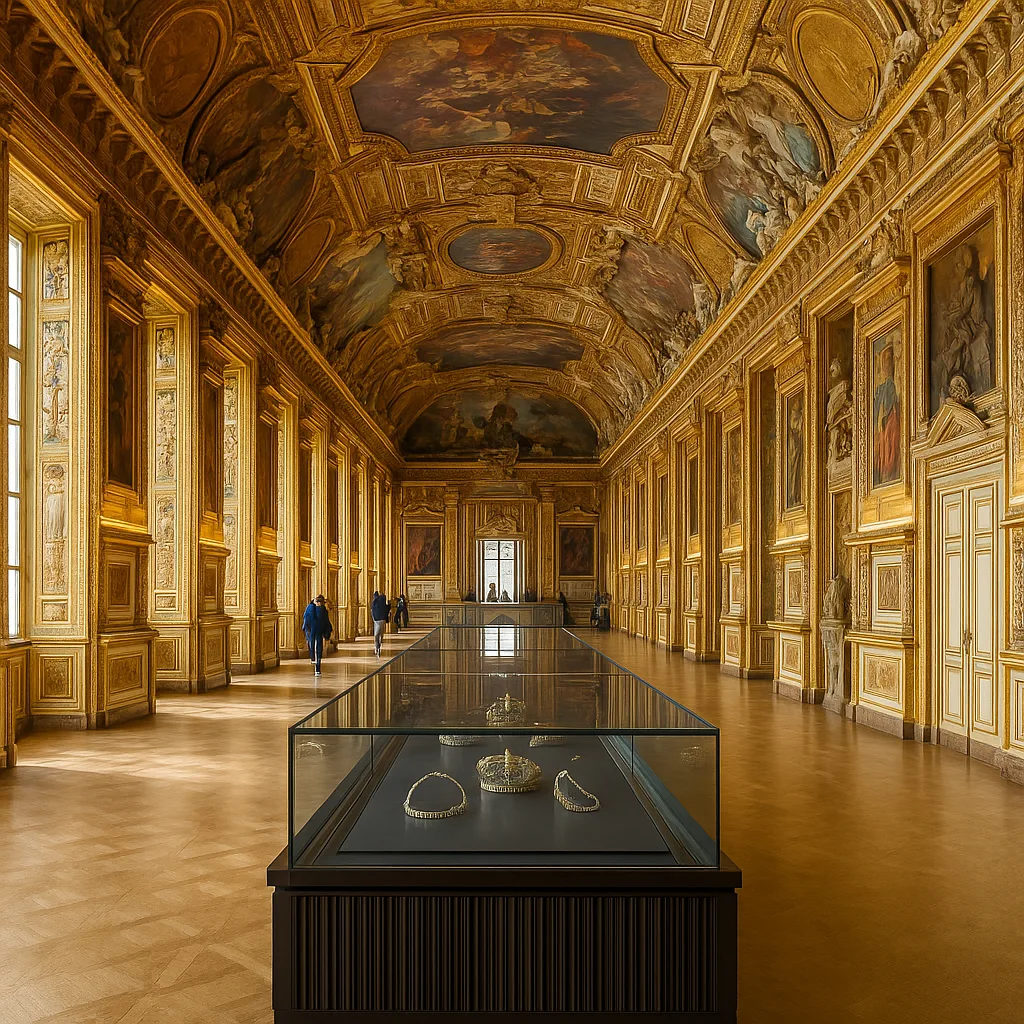Introduction: The Great Louvre Heist
In the heart of Paris — inside the world’s most famous museum — unfolded a heist so audacious it could outshine any Hollywood script.
On October 19, 2025, the Louvre Museum became the scene of a lightning-fast robbery where thieves stole royal jewellery worth ₹12 crore (€88 million), vanishing without a trace.
These weren’t just gemstones; they were living pieces of French history — emeralds once worn by queens, sapphires gifted by emperors, and crowns forged for royalty. Their disappearance marked one of the greatest cultural losses of modern times.
The Heist: Seven Minutes That Shook Paris
At 9:30 a.m., amid the quiet hum of tourists, four men disguised as maintenance workers arrived at the Galerie d’Apollon — the Louvre’s glittering hall of crown jewels.
Using a truck-mounted lift, they ascended to a first-floor balcony, smashed open reinforced display cases with industrial-grade tools, and escaped within seven minutes.
Two fled on scooters through side alleys; the others drove the truck away before alarms fully triggered.
Paris Prosecutor Laure Beccuau confirmed that eight priceless pieces had been stolen — each carrying not just monetary but immeasurable historical value.

What Was Stolen: The Treasures of France’s Royal Past
The thieves didn’t strike at random. Their targets were France’s most valuable symbols of monarchy — pieces dating from the Napoleonic and Bourbon dynasties.
1. Napoleon’s Emerald Necklace (1810)
Gifted by Napoleon Bonaparte to his wife Marie-Louise of Austria, this necklace shimmered with dozens of Colombian emeralds and over 1,000 diamonds — the centerpiece of the French imperial collection.
2. Empress Eugénie’s Diamond Crown
Commissioned in 1853 by Emperor Napoleon III, this crown contained 2,000 diamonds and 200 pearls, forming floral and eagle motifs symbolic of the Second Empire.
3. Queen Marie-Amélie’s Sapphire Diadem & Necklace
The sapphire-and-diamond set once belonged to France’s last Bourbon queen, Marie-Amélie. Its deep blue stones represented serenity and power — values long associated with the royal family.
4. Empress Eugénie’s Bow Brooch
A diamond bow-shaped ornament crafted by the House of Lemonnier, once pinned to the Empress’s ceremonial gowns.
5. The Lost Crown of Eagles
One damaged crown, adorned with golden eagles and 56 emeralds, was later found shattered near the museum — a sign of the thieves’ rushed escape.
Inside the Operation: Planning Like a Movie Plot
Security experts call it a “surgical strike.”
The robbers exploited a maintenance loophole, entering during partial renovation work. They wore reflective vests, carried diamond-tipped cutters, and targeted a blind spot in the museum’s external surveillance system.
Each step was timed — from guard rotation to sensor delay — allowing the gang to slip in and out before police could react.
No fingerprints. No faces on camera. No trace of the jewels.
Authorities now believe the group belonged to an organized European art-crime syndicate familiar with museum layouts and gemstone trafficking networks.
Also read – The Truths About Dubai’s Real Estate Bubble
The Investigation: France’s Race Against Time
After the heist, over 100 investigators joined forces with Interpol. CCTV footage captured fleeting images of two scooters speeding away but no identifiable details.
Paris’s prosecutor described the operation as “meticulously coordinated by professionals who knew exactly what to steal.”
Interpol alerts were issued across Europe, while customs and jewellers were instructed to flag rare emerald or sapphire stones matching the stolen pieces.
Yet, as days turned into weeks, no concrete leads emerged.
Why Experts Say the Jewels May Never Be Recovered
Jewellery theft is unlike art theft.
Paintings can be recognized; sculptures have serial records. But jewels can vanish forever in hours.
Experts outline two grim possibilities:
Scenario 1 — Dismantling and Melting
Thieves might extract stones, re-cut them, and melt gold settings to erase their heritage identity. Once altered, they become ordinary gems — impossible to trace.
Scenario 2 — Private Collectors
There’s a darker possibility: a secret buyer commissioned the heist.
Some collectors purchase stolen masterpieces purely for private possession — trophies hidden in vaults, never to be seen again.
As a gem expert told The Times of India:
“It’s extremely unlikely these jewels will ever be retrieved or even seen again. If they’re broken up, they’ve vanished from history.”
Cultural Shockwaves Across the World
For France, the robbery wasn’t just financial — it was emotional.
The stolen jewels symbolized the grandeur of French craftsmanship, connecting the modern republic to its royal lineage.
The Galerie d’Apollon was sealed for forensic examination. The Louvre temporarily closed, prompting panic across Europe’s heritage community.
Museums in London, Vienna, and St Petersburg immediately reviewed security. Insurance companies began rewriting coverage clauses for high-value exhibits.
Cultural historian Élodie Moreau summed it up:
“We didn’t just lose jewels — we lost our living connection to history.”
The Louvre’s Dark History of Thefts
Believe it or not, this isn’t the Louvre’s first encounter with theft.
| Year | Incident | Outcome |
|---|---|---|
| 1911 | Mona Lisa Theft — Italian worker Vincenzo Peruggia hid inside the museum overnight and stole the painting. | Recovered 1913 |
| 1998 | Two separate robberies involving smaller paintings, including one by Camille Corot. | Both recovered |
| 2025 | The Great Louvre Heist — eight royal jewels stolen in seven minutes. | Unrecovered |
Elsewhere, other museums suffered similar fates:
- 2019 – Dresden Green Vault Heist: €113 million in Baroque jewels stolen (partially recovered).
- 1990 – Isabella Stewart Gardner Museum (Boston): 13 artworks worth $500 million missing to date.
The Louvre Heist 2025 now sits beside these legendary crimes — not for glory, but as a warning.
Public Reaction: Outrage, Shock, and Viral Theories
In Paris, anger turned into collective mourning.
#BringBackOurCrown trended across French Twitter. Memes compared the robbers to the Money Heist crew, yet beneath the humour was heartbreak.
Curators called it a “tragedy for civilization”, and ordinary citizens queued outside the museum gates in disbelief.
Many asked: “If the Louvre isn’t safe, what is?”
Lessons from the Heist
- Even icons need updates. The world’s top museum ran parts of its security on outdated tech.
- Maintenance = vulnerability. Renovations created blind spots that thieves exploited.
- The 48-hour rule. If stolen jewels aren’t recovered within two days, they almost never resurface.
- Global cooperation is key. Art crimes transcend borders; so should protection.
Could the Jewels Ever Return?
History says — maybe.
The Mona Lisa returned after two years. Dresden’s jewels resurfaced after four.
But jewellery heists are different: metals melt, stones recut, proof disappears.
Unless a thief confesses or a collector slips up, the emeralds of Napoleon and sapphires of Marie-Amélie may remain buried in the shadows of the black market.
Still, the story continues to inspire artists, filmmakers, and crime historians. Netflix producers have reportedly shown interest in adapting the incident for a docu-series — proof that the legend of the Louvre Eight is far from over.
Conclusion: When History Fades Into Shadows
The Louvre Heist 2025 isn’t just about lost treasure — it’s about how fragile our cultural memory can be.
In seven minutes, centuries of art, love, and craftsmanship disappeared.
These weren’t mere jewels — they were witnesses to revolutions, marriages, and empires.
Their sparkle once lit the corridors of power; today, they illuminate a painful truth: even history’s greatest symbols can vanish in the blink of an eye.
But as long as the world keeps telling their story, the brilliance of the Louvre’s lost jewels will never truly fade.
FOR MORE UPDATES & VIDEOS ON CURRENT AFFAIRS SUBSCRIBE TO THE LOGIC STICK






